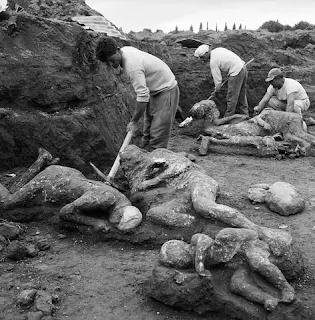The tragic history of Pompeii, the Roman city buried under volcanic ash and rediscovered after 1,500 years.
 |
| Frozen Bodies of Pompeii / Image Credit: Flickr |
Nestled in southern Italy near modern-day Naples, Pompeii city flourished as a lively and affluent Roman settlement during the first century AD. Known for its vibrant marketplaces, luxurious villas, and progressive culture, Pompeii or Pompei became a beacon of Roman innovation and lifestyle. With Mount Vesuvius Pompeii towering silently in the background, locals never suspected that the sleeping giant would one day unleash one of the deadliest volcanic disasters in human history.
The Day Mount Vesuvius Changed Everything
On the fateful morning of August 24, 79 AD, the unthinkable occurred. Without warning, Pompeii Volcano Eruption began as Vesuvius hurled molten rock over 15 kilometers into the sky. Day turned to night as thick clouds of ash and pumice blocked the sun. In less than 24 hours, over four billion tons of volcanic material smothered the city.
 |
| Mount Vesuvius Volcanic Eruption / Image Credit: Wikimedia |
Pompeii Vesuvius became a name that echoed through time, marking the tragic encounter between nature’s fury and human fragility.
As the eruption intensified, pyroclastic flows—fast-moving waves of ash, gas, and debris—swept down the volcano at terrifying speeds. The first surge halted short of the city, but what happened to the city of Pompeii next was catastrophic. Toxic gases and falling ash suffocated thousands. By the time the final pyroclastic wave arrived, it smashed through stone walls and left entire households buried. The once-thriving community was now a ghost town—its people, streets, and daily life frozen in volcanic time.
The Rediscovery of Pompeii Bodies
 |
| Excavating Bodies at Pompeii, Italy / Image Credit: Flickr |
When was Pompeii rediscovered? It happened in 1594, more than 1500 years after the eruption. While digging for a water channel, workers stumbled upon strange ruins buried under hardened ash. Over time, archaeologists uncovered homes, frescoes, and even the haunting bodies Pompeii left behind, preserved in perfect stillness by layers of ash. Today, the ruins of Pompeii offer one of the most detailed windows into ancient Roman life.
Modern visitors can explore the archaeological park of Pompeii, walking through the same streets where ancient Romans once lived, laughed, and loved. This UNESCO World Heritage Site attracts millions who come to witness the Italy Pompeii ruins and ponder the fragility of civilization. For those asking where is Pompeii, it sits in the Campania region of Italy, just a short ride from Naples—both breathtaking and somber in its silence.
Is Mount Vesuvius Still Active Today?
Yes—Mount Vesuvius is still considered an active volcano, and it's one of the most dangerous in the world due to its proximity to densely populated areas. Though its last major eruption was in 1944, scientists constantly monitor the volcano’s activity. The story of Pompeii, reminding us that nature’s power is ever-present.
 |
| Panoramic View of Mount Vesuvius, Pompeii / Image Credit: Wikimedia |
Today, extensive emergency plans are in place around Pompeii location to protect the millions living nearby. While the mountain appears calm, the memory of its deadly past never fades.
From Tragedy to Pop Culture: The Story of Pompeii Lives On
The legacy of the story of Pompeii continues to inspire books, documentaries, and even a movie about Pompeii. Films like Pompeii the movie dramatize the eruption, but nothing matches the real-life remains of the city. Whether you're watching a film Pompeii adaptation or reading ancient texts, story Pompeii narratives never fail to evoke awe.
The Story of Pompeii destruction
History about Pompeii isn’t just about volcanic tragedy; it's about people. From bakeries to amphitheaters, bathhouses to brothels, everything remains almost untouched under the ash. The history of Pompeii reveals not just the end of a city, but the daily rhythms of life paused by nature. It’s a poignant reminder of our shared vulnerability.
The curiosity surrounding Pompeii the story persists not just for its archaeology, but for the emotional imprint it leaves. Ask someone what country is Pompeii in, and they might pause before realizing it’s one of Italy’s most iconic historical sites. The city's destruction, rediscovery, and preservation continue to shape modern understanding of ancient civilization.
